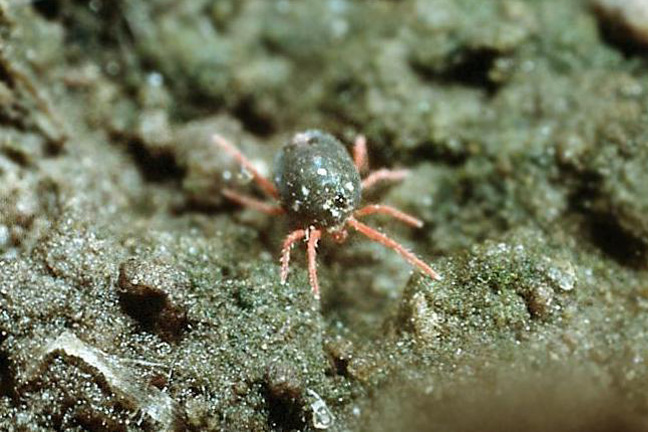
Agricultural News
Mites and Moths: A Fall for Keeping a Vigilant Watch on Wheat and Canola
Fri, 02 Nov 2012 16:56:34 CDT

Mike Jeffcoat, Extension Educator Ag in Jefferson County reported a wheat field that was heavily infested with winter grain mite (WGM) which is also called the blue oat mite. I was a bit surprised at the levels of damage he was seeing, but a dry fall, coupled with a cooling of temps and slow growth of wheat means the wheat is vulnerable to this pest.
This mite is small (about the 1 mm long) with a dark blue to black body and 4 pair of orange-red legs. It also has a small reddish spot on the top of its abdomen that can be seen under magnification. The eggs of WGM are kidney-shaped, and change from clear, to yellow to reddish-orange after several days. They are laid on leaf blades and stems or the roots near the crown. Besides wheat, many grasses serve as host plants, including barley, oats, ryegrass and fescue.
In all cases, adult mites are females, all of which are capable of laying eggs. The first generation will peak in December/January and the second will peak in March/April. Newly- hatched take up to 60 days to mature and can live for up to 40 days as adults. Winter grain mites oversummer as eggs. They are most active when temperatures are between 40 degrees and 70 degrees F. Freezing conditions and/or snow cover don't really affect them.
Winter grain mites feed by piercing plant cells in the leaf, which results in "stippling". As injury continues, the leaves take on a characteristic grayish or silverfish cast and could be mistaken for injury due to herbicide. Winter grain mites are more likely to cause injury in wheat if it is already stressed due to lack of moisture or nutrients. Winter grain mites are light sensitive and tend to avoid bright, sunny days and windy days, so adjust your scouting accordingly. On still, cloudy days or early morning/evening, they will be active on the surface (up to a couple of inches) or massed under dirt clods.
Winter grain mites are more common in fields of continuous wheat and they are reported to do better in fields that have a minimum amount of tillage applied to them. Winter grain mites do not typically cause extreme injury unless present in excessive numbers and plant growing conditions do not sustain rapid growth of wheat foliage, such as when an infestation is coupled with nitrogen deficiency or under drought stress. While WGM pests can damage wheat even under normal growing conditions, it takes large numbers to justify an insecticide application for their control. There is no established threshold for WGM; my best "guestimation" is to treat when injury symptoms are visible and mite numbers exceed 10 per plant.
There are few insecticides that include WGM on the label, but they can probably be controlled with other products registered for use in wheat. Check CR-7194, Management of Insect and Mite Pests in Small Grains for registered insecticides, application rates, and grazing/harvest waiting periods. It can be obtained online by clicking here.
I have also received reports of some canola fields that were infested with diamondback moths. This infestation on seedlings is turning out to be a "regular" occurrence in winter canola country.
The diamondback moth is a small, gray and brown moth that measures ½ inches. When resting, the wings fold over the body in a roof like position. Male moths have three diamond-shaped markings on their folded forewings, which is how it got its name (Figure 1). Female moths lay oval flattened eggs measuring 0.44 mm in groups of 1-8 eggs which will hatch in 5-6 days. One female will lay an average of 150 eggs.
Newly hatched larvae are light green with a green head, and become progressively darker as they mature. They develop through four instars and measure about ½ inches long when full grown. Larvae create a loose, silken cocoon that they attach to the plant and pupate within. They can complete a lifecycle in about 32 days, depending on temperature. Typically a scout will find all life stages at the same time within a field. One distinct feature of this caterpillar is that it will thrash violently back and forth and drop from the plant on a silk strand when disturbed.
When larvae first hatch, they feed by leaf mining. Small larvae chew small irregular windowpane areas on a leaf. As they get larger, they can destroy entire leaves leaving only the veins.
Scout for diamondback moth by examining individual plants in several areas of the field. You may have to examine the plants very closely, because these caterpillars like to dig themselves in and hide. We don't have published thresholds to guide us, but our best suggestion is to treat them similar to beet armyworms, but increase the threshold a bit because they are smaller and "eat less" than a full grown beet armyworm.
Our suggested threshold is: 2-3 larvae per row foot at seedling stage.
For control options, consult CR-7667, Management of Insect and Mite Pests in Canola which can be obtained online by clicking here.
WebReadyTM Powered by WireReady® NSI
Top Agricultural News
More Headlines...



















